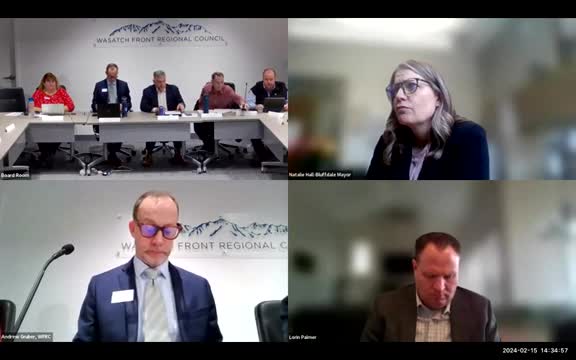Bryce Bridal discusses Utah's ozone compliance challenges with federal standards
February 21, 2024 | Transportation Coordinating Committee, Wasatch Front Regional Council, Wasatch County Commission and Boards, Wasatch County, Utah

This article was created by AI summarizing key points discussed. AI makes mistakes, so for full details and context, please refer to the video of the full meeting. Please report any errors so we can fix them. Report an error »

The Wasatch County Transportation Coordinating Committee meeting on February 15, 2024, addressed a pressing issue regarding air quality standards and their implications for transportation projects in Utah. Bryce Bridal, Executive Director of the State Division of Air Quality, presented a detailed overview of the challenges posed by federal ozone regulations, which could significantly impact local transportation funding and planning.
Bridal explained that while Utah has made substantial progress in reducing emissions—largely due to cleaner vehicles and increased transportation options—the state is now facing stricter federal ozone standards. Currently, 86% of the ozone affecting Utah's air quality originates from external sources, including emissions from California and even international contributions from places like China. This background ozone complicates efforts to meet federal standards, which have been tightened in recent years.
The implications of failing to meet these standards are serious. If Utah cannot demonstrate compliance, it risks facing restrictions on the use of federal, state, and local transportation funds. This could affect not only road projects but also transit initiatives aimed at reducing vehicle emissions and improving air quality.
Bridal emphasized the importance of understanding these regulatory challenges, as they could hinder the region's ability to implement necessary transportation improvements. The Clean Air Act mandates that if a region does not make sufficient progress in meeting air quality standards, the Environmental Protection Agency (EPA) can impose sanctions, including requiring industrial sources to offset emissions at a rate of two-to-one.
The committee members expressed concern about the difficulty of addressing the external factors contributing to ozone levels, particularly given the significant progress made within Utah itself. As the meeting concluded, it was clear that the committee must navigate these complex air quality regulations while continuing to advocate for effective transportation solutions that benefit the community.
In summary, the discussions highlighted the intersection of air quality regulations and transportation planning, underscoring the need for collaborative efforts to address both local and external sources of pollution. The committee's awareness of these issues will be crucial as they work towards sustainable transportation solutions that align with federal standards and community needs.
Bridal explained that while Utah has made substantial progress in reducing emissions—largely due to cleaner vehicles and increased transportation options—the state is now facing stricter federal ozone standards. Currently, 86% of the ozone affecting Utah's air quality originates from external sources, including emissions from California and even international contributions from places like China. This background ozone complicates efforts to meet federal standards, which have been tightened in recent years.
The implications of failing to meet these standards are serious. If Utah cannot demonstrate compliance, it risks facing restrictions on the use of federal, state, and local transportation funds. This could affect not only road projects but also transit initiatives aimed at reducing vehicle emissions and improving air quality.
Bridal emphasized the importance of understanding these regulatory challenges, as they could hinder the region's ability to implement necessary transportation improvements. The Clean Air Act mandates that if a region does not make sufficient progress in meeting air quality standards, the Environmental Protection Agency (EPA) can impose sanctions, including requiring industrial sources to offset emissions at a rate of two-to-one.
The committee members expressed concern about the difficulty of addressing the external factors contributing to ozone levels, particularly given the significant progress made within Utah itself. As the meeting concluded, it was clear that the committee must navigate these complex air quality regulations while continuing to advocate for effective transportation solutions that benefit the community.
In summary, the discussions highlighted the intersection of air quality regulations and transportation planning, underscoring the need for collaborative efforts to address both local and external sources of pollution. The committee's awareness of these issues will be crucial as they work towards sustainable transportation solutions that align with federal standards and community needs.
View full meeting
This article is based on a recent meeting—watch the full video and explore the complete transcript for deeper insights into the discussion.
View full meeting

